2016 NISSAN MURANO HYBRID glove box
[x] Cancel search: glove boxPage 24 of 443
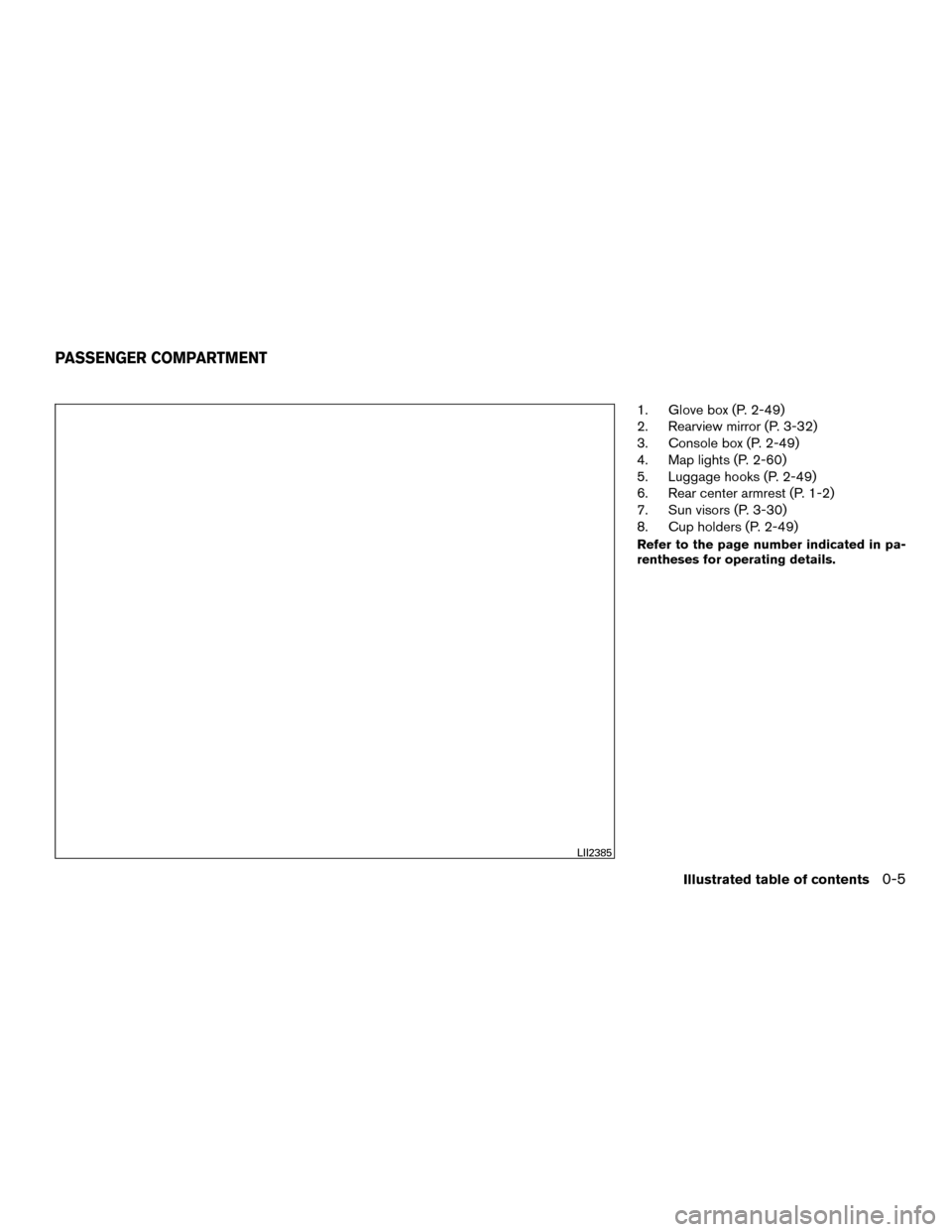
1. Glove box (P. 2-49)
2. Rearview mirror (P. 3-32)
3. Console box (P. 2-49)
4. Map lights (P. 2-60)
5. Luggage hooks (P. 2-49)
6. Rear center armrest (P. 1-2)
7. Sun visors (P. 3-30)
8. Cup holders (P. 2-49)
Refer to the page number indicated in pa-
rentheses for operating details.
LII2385
PASSENGER COMPARTMENT
Illustrated table of contents0-5
Page 25 of 443
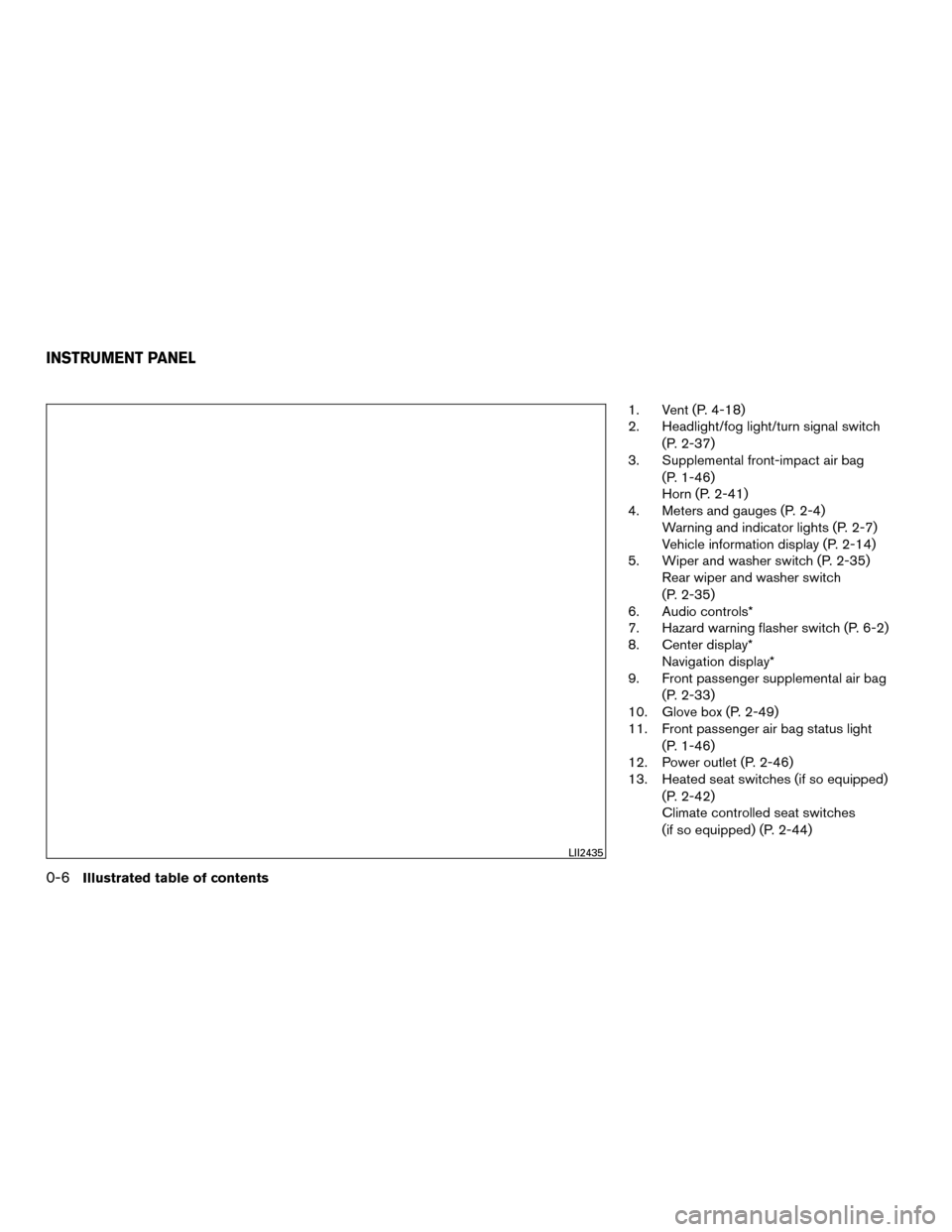
1. Vent (P. 4-18)
2. Headlight/fog light/turn signal switch(P. 2-37)
3. Supplemental front-impact air bag
(P. 1-46)
Horn (P. 2-41)
4. Meters and gauges (P. 2-4) Warning and indicator lights (P. 2-7)
Vehicle information display (P. 2-14)
5. Wiper and washer switch (P. 2-35) Rear wiper and washer switch
(P. 2-35)
6. Audio controls*
7. Hazard warning flasher switch (P. 6-2)
8. Center display* Navigation display*
9. Front passenger supplemental air bag
(P. 2-33)
10. Glove box (P. 2-49)
11. Front passenger air bag status light
(P. 1-46)
12. Power outlet (P. 2-46)
13. Heated seat switches (if so equipped)
(P. 2-42)
Climate controlled seat switches
(if so equipped) (P. 2-44)
LII2435
INSTRUMENT PANEL
0-6Illustrated table of contents
Page 84 of 443
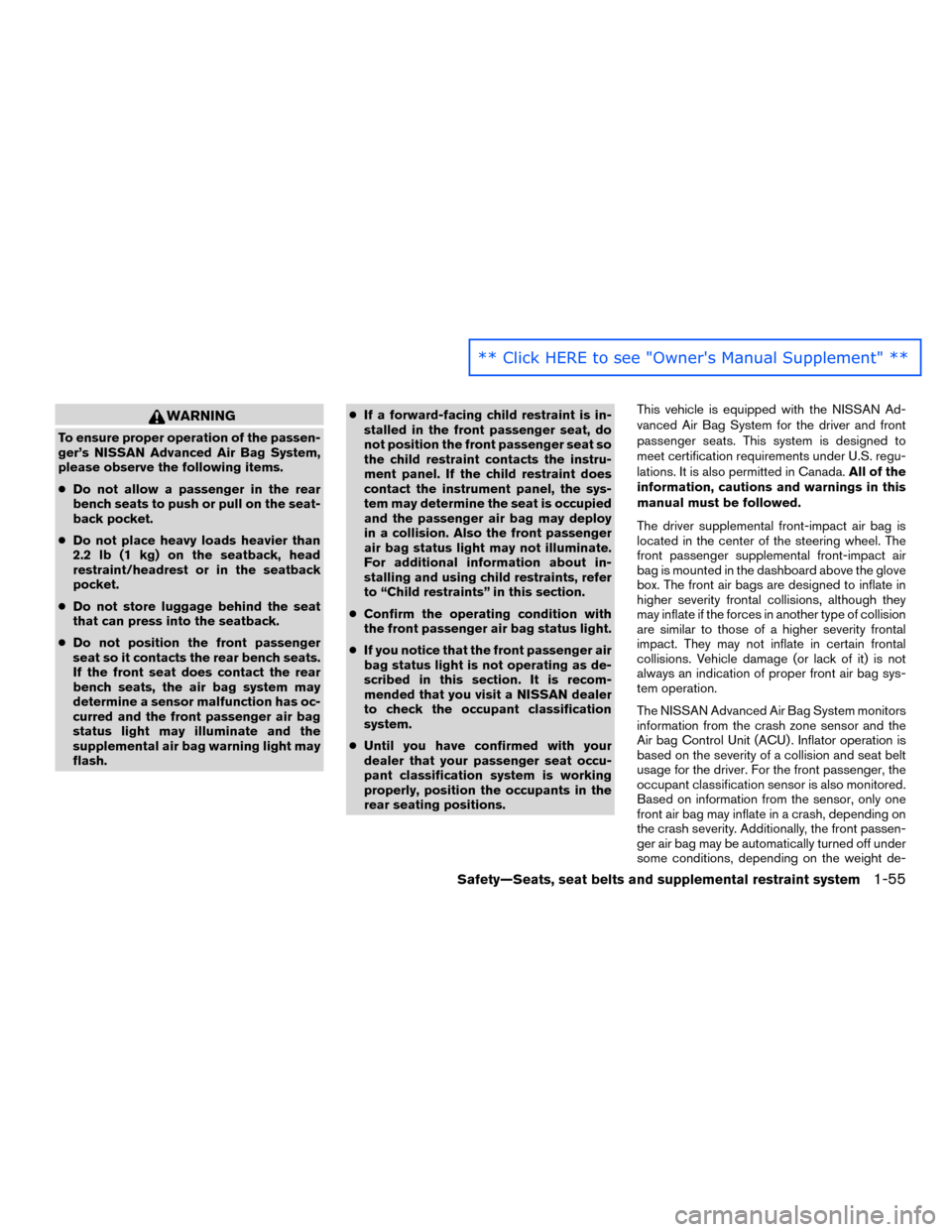
WARNING
To ensure proper operation of the passen-
ger’s NISSAN Advanced Air Bag System,
please observe the following items.
●Do not allow a passenger in the rear
bench seats to push or pull on the seat-
back pocket.
● Do not place heavy loads heavier than
2.2 lb (1 kg) on the seatback, head
restraint/headrest or in the seatback
pocket.
● Do not store luggage behind the seat
that can press into the seatback.
● Do not position the front passenger
seat so it contacts the rear bench seats.
If the front seat does contact the rear
bench seats, the air bag system may
determine a sensor malfunction has oc-
curred and the front passenger air bag
status light may illuminate and the
supplemental air bag warning light may
flash. ●
If a forward-facing child restraint is in-
stalled in the front passenger seat, do
not position the front passenger seat so
the child restraint contacts the instru-
ment panel. If the child restraint does
contact the instrument panel, the sys-
tem may determine the seat is occupied
and the passenger air bag may deploy
in a collision. Also the front passenger
air bag status light may not illuminate.
For additional information about in-
stalling and using child restraints, refer
to “Child restraints” in this section.
● Confirm the operating condition with
the front passenger air bag status light.
● If you notice that the front passenger air
bag status light is not operating as de-
scribed in this section. It is recom-
mended that you visit a NISSAN dealer
to check the occupant classification
system.
● Until you have confirmed with your
dealer that your passenger seat occu-
pant classification system is working
properly, position the occupants in the
rear seating positions. This vehicle is equipped with the NISSAN Ad-
vanced Air Bag System for the driver and front
passenger seats. This system is designed to
meet certification requirements under U.S. regu-
lations. It is also permitted in Canada.
All of the
information, cautions and warnings in this
manual must be followed.
The driver supplemental front-impact air bag is
located in the center of the steering wheel. The
front passenger supplemental front-impact air
bag is mounted in the dashboard above the glove
box. The front air bags are designed to inflate in
higher severity frontal collisions, although they
may inflate if the forces in another type of collision
are similar to those of a higher severity frontal
impact. They may not inflate in certain frontal
collisions. Vehicle damage (or lack of it) is not
always an indication of proper front air bag sys-
tem operation.
The NISSAN Advanced Air Bag System monitors
information from the crash zone sensor and the
Air bag Control Unit (ACU) . Inflator operation is
based on the severity of a collision and seat belt
usage for the driver. For the front passenger, the
occupant classification sensor is also monitored.
Based on information from the sensor, only one
front air bag may inflate in a crash, depending on
the crash severity. Additionally, the front passen-
ger air bag may be automatically turned off under
some conditions, depending on the weight de-
Safety—Seats, seat belts and supplemental restraint system1-55
** Click HERE to see "Owner's Manual Supplement" **
Page 100 of 443
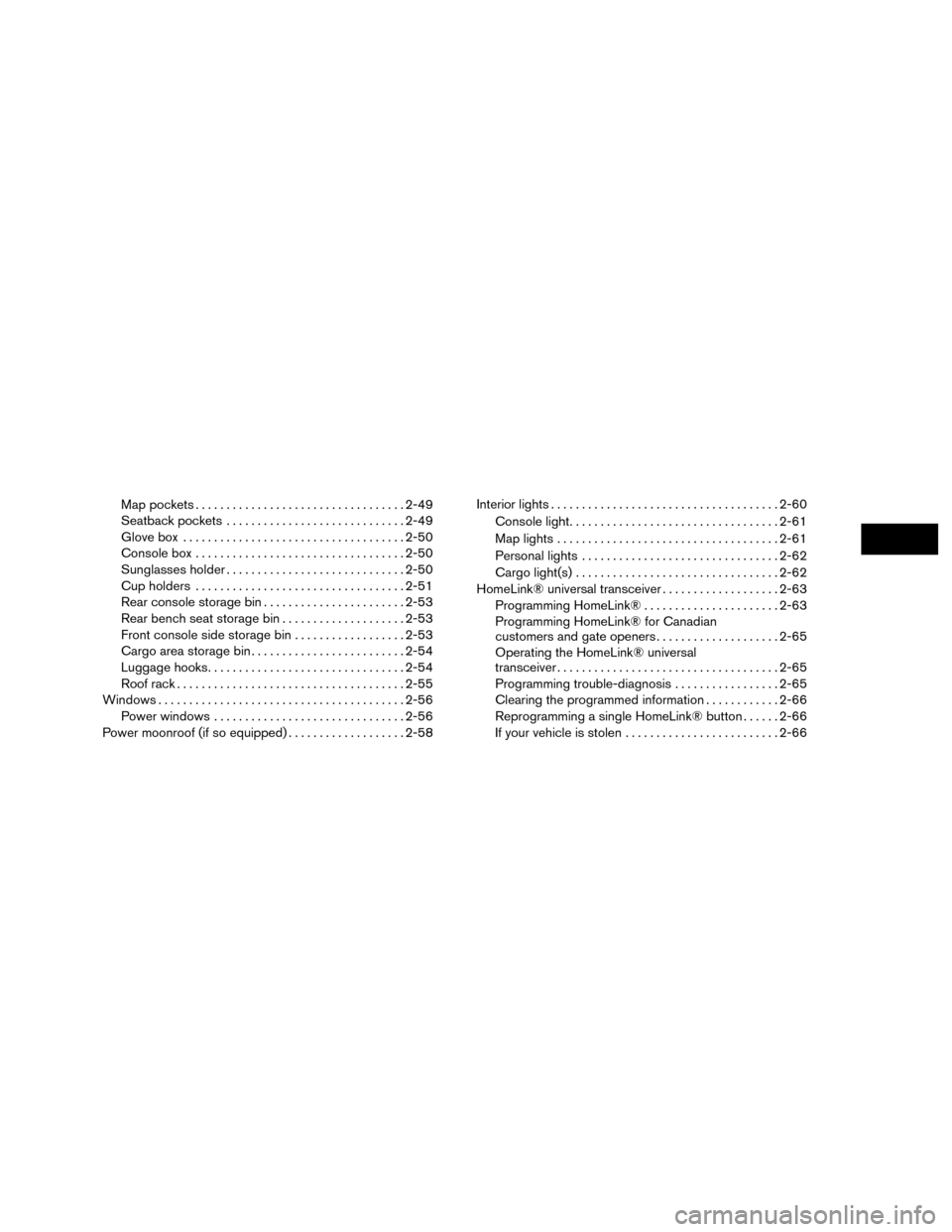
Map pockets.................................. 2-49
Seatback pockets ............................. 2-49
Glove box .................................... 2-50
Console box .................................. 2-50
Sunglasses holder ............................. 2-50
Cup holders .................................. 2-51
Rear console storage bin .......................2-53
Rear bench seat storage bin ....................2-53
Front console side storage bin . . ................2-53
Cargo area storage bin ......................... 2-54
Luggage hooks ................................ 2-54
Roof rack ..................................... 2-55
Windows ........................................ 2-56
Power windows ............................... 2-56
Power moonroof (if so equipped) ...................2-58Interior lights
..................................... 2-60
Console light .................................. 2-61
Map lights .................................... 2-61
Personal lights ................................ 2-62
Cargo light(s) ................................. 2-62
HomeLink® universal transceiver ...................2-63
Programming HomeLink® ......................2-63
Programming HomeLink® for Canadian
customers and gate openers ....................2-65
Operating the HomeLink® universal
transceiver .................................... 2-65
Programming trouble-diagnosis .................2-65
Clearing the programmed information ............2-66
Reprogramming a single HomeLink® button ......2-66
If your vehicle is stolen ......................... 2-66
Page 101 of 443
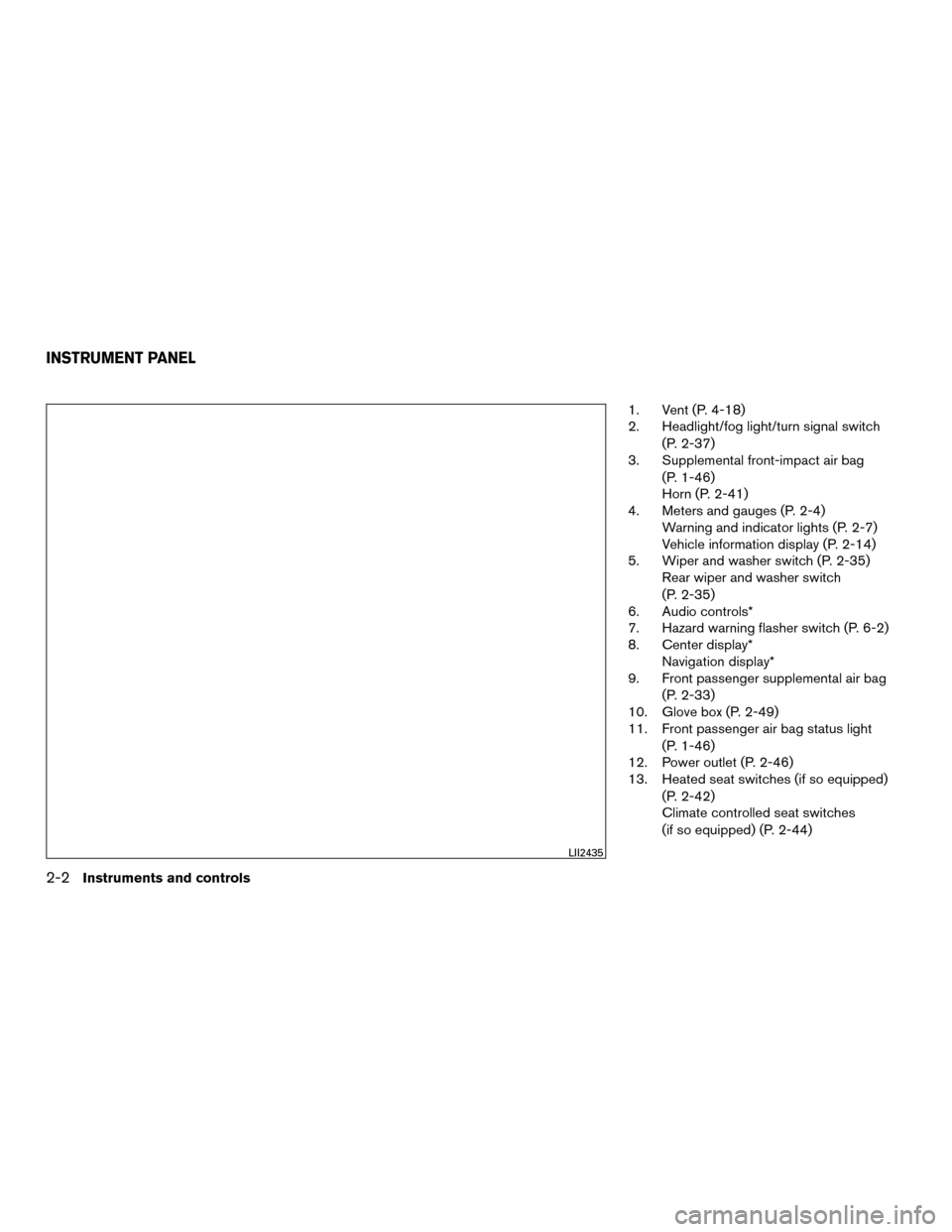
1. Vent (P. 4-18)
2. Headlight/fog light/turn signal switch(P. 2-37)
3. Supplemental front-impact air bag
(P. 1-46)
Horn (P. 2-41)
4. Meters and gauges (P. 2-4) Warning and indicator lights (P. 2-7)
Vehicle information display (P. 2-14)
5. Wiper and washer switch (P. 2-35) Rear wiper and washer switch
(P. 2-35)
6. Audio controls*
7. Hazard warning flasher switch (P. 6-2)
8. Center display* Navigation display*
9. Front passenger supplemental air bag
(P. 2-33)
10. Glove box (P. 2-49)
11. Front passenger air bag status light
(P. 1-46)
12. Power outlet (P. 2-46)
13. Heated seat switches (if so equipped)
(P. 2-42)
Climate controlled seat switches
(if so equipped) (P. 2-44)
LII2435
INSTRUMENT PANEL
2-2Instruments and controls
Page 149 of 443
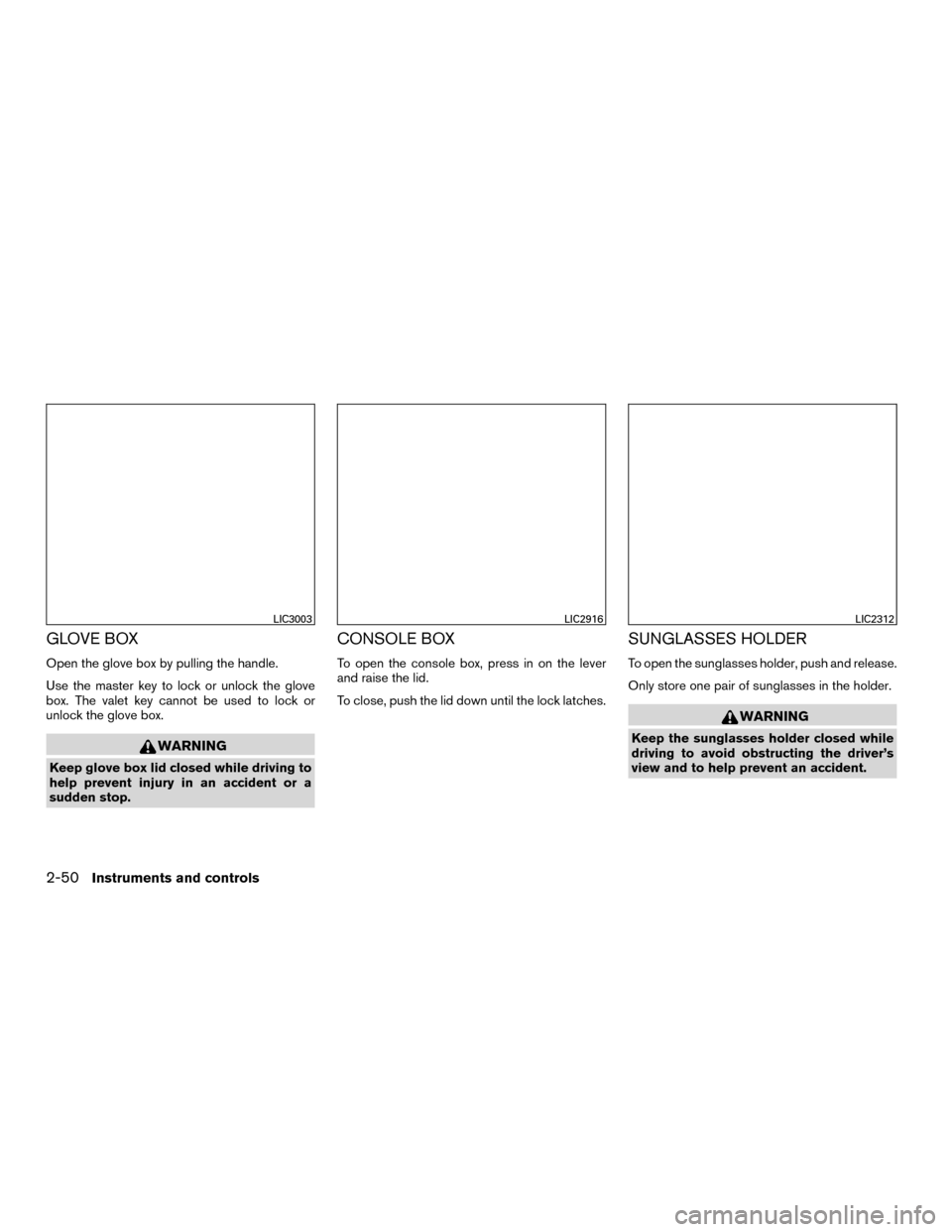
GLOVE BOX
Open the glove box by pulling the handle.
Use the master key to lock or unlock the glove
box. The valet key cannot be used to lock or
unlock the glove box.
WARNING
Keep glove box lid closed while driving to
help prevent injury in an accident or a
sudden stop.
CONSOLE BOX
To open the console box, press in on the lever
and raise the lid.
To close, push the lid down until the lock latches.
SUNGLASSES HOLDER
To open the sunglasses holder, push and release.
Only store one pair of sunglasses in the holder.
WARNING
Keep the sunglasses holder closed while
driving to avoid obstructing the driver’s
view and to help prevent an accident.
LIC3003LIC2916LIC2312
2-50Instruments and controls
Page 170 of 443

Mechanical key
The Intelligent Key contains the mechanical key.
To remove the mechanical key, release the lock
knob on the back of the Intelligent Key.
To install the mechanical key, firmly insert it into
the Intelligent Key until the lock knob returns to
the lock position.
Use the mechanical key to lock or unlock the
driver’s door.
CAUTION
Always carry the mechanical key installed
in the Intelligent Key slot.
For additional information, refer to “Doors” in this
section.
Valet hand-off
When you have to leave a key with a valet, give
them the Intelligent Key itself and keep the me-
chanical key with you to protect your belongings.
To prevent the glove box from being opened
during valet hand-off, follow the procedure be-
low. 1. Remove the mechanical key from the Intelli- gent Key.
2. Lock the glove box with the mechanical key.
3. Hand the Intelligent Key to the valet and keep the mechanical key with you.
For additional information, refer to “Storage” in
the “Instruments and controls” section of this
manual.
NISSAN VEHICLE IMMOBILIZER
SYSTEM KEYS
You can only drive your vehicle using the Intelli-
gent Keys which are registered to the NISSAN
Vehicle Immobilizer System components in your
vehicle.
The mechanical key can be used for all the locks.
Never leave the keys in the vehicle.
Additional or replacement keys:
If you still have a key, the key number is not
necessary when you need extra NISSAN Vehicle
Immobilizer System keys. Your existing key can
be duplicated without knowing the key number.
As many as four NISSAN Vehicle Immobilizer
System keys can be used with one vehicle. You
should bring all NISSAN Vehicle Immobilizer Sys-
tem keys that you have to the NISSAN dealer for
registration. This is because the registration pro-
cess will erase the memory of all key codes
previously registered into the NISSAN Vehicle
Immobilizer System. After the registration pro-
cess, these components will only recognize keys
coded into the NISSAN Vehicle Immobilizer Sys-
tem during registration. Any key that is not given
to the dealer at the time of registration will no
longer be able to start your vehicle.
SPA1951
Pre-driving checks and adjustments3-3
Page 177 of 443
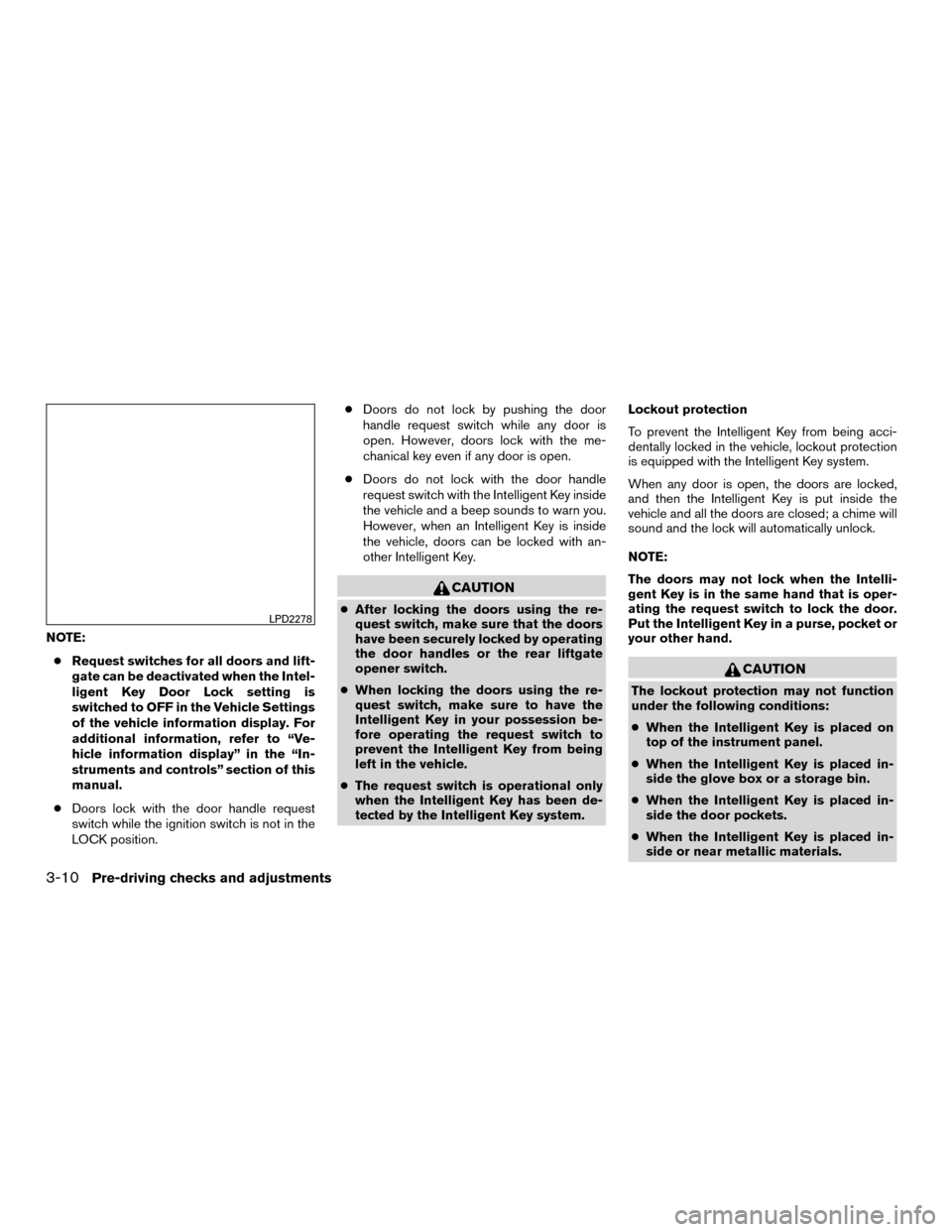
NOTE:● Request switches for all doors and lift-
gate can be deactivated when the Intel-
ligent Key Door Lock setting is
switched to OFF in the Vehicle Settings
of the vehicle information display. For
additional information, refer to “Ve-
hicle information display” in the “In-
struments and controls” section of this
manual.
● Doors lock with the door handle request
switch while the ignition switch is not in the
LOCK position. ●
Doors do not lock by pushing the door
handle request switch while any door is
open. However, doors lock with the me-
chanical key even if any door is open.
● Doors do not lock with the door handle
request switch with the Intelligent Key inside
the vehicle and a beep sounds to warn you.
However, when an Intelligent Key is inside
the vehicle, doors can be locked with an-
other Intelligent Key.
CAUTION
●After locking the doors using the re-
quest switch, make sure that the doors
have been securely locked by operating
the door handles or the rear liftgate
opener switch.
● When locking the doors using the re-
quest switch, make sure to have the
Intelligent Key in your possession be-
fore operating the request switch to
prevent the Intelligent Key from being
left in the vehicle.
● The request switch is operational only
when the Intelligent Key has been de-
tected by the Intelligent Key system. Lockout protection
To prevent the Intelligent Key from being acci-
dentally locked in the vehicle, lockout protection
is equipped with the Intelligent Key system.
When any door is open, the doors are locked,
and then the Intelligent Key is put inside the
vehicle and all the doors are closed; a chime will
sound and the lock will automatically unlock.
NOTE:
The doors may not lock when the Intelli-
gent Key is in the same hand that is oper-
ating the request switch to lock the door.
Put the Intelligent Key in a purse, pocket or
your other hand.
CAUTION
The lockout protection may not function
under the following conditions:
●
When the Intelligent Key is placed on
top of the instrument panel.
● When the Intelligent Key is placed in-
side the glove box or a storage bin.
● When the Intelligent Key is placed in-
side the door pockets.
● When the Intelligent Key is placed in-
side or near metallic materials.
LPD2278
3-10Pre-driving checks and adjustments